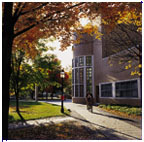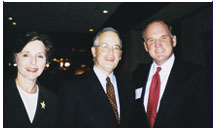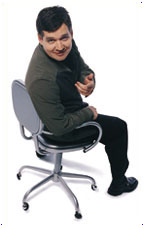|
March 7, 2001: Notebook Princeton Borough threatens to crack down on the eating clubs A final lap: President Shapiro, on the road, thanks volunteers Bestsellers at campus bookstores “You like weird
things,” said Clarence Brown, professor of comparative literature,
to Eileen Reeves. “You take it over.” So when Brown retired,
Reeves began teaching his course, Comparative Literature 337, Really
Fantastic Fiction, which deals with realist writers — Nikolai
Gogol, Henry James, Gabriel Garc'a Marquez — who introduce
the supernatural into their books. Reeves, an associate
professor, does respected scholarly work (the Princeton University
Press published her Painting the Heavens: Art and Science in the
Age of Galileo in 1997, and she teaches literature of the Renaissance
and comparative literature theory for graduate students) but she
also does things that are, well, different. The idea of life on other
planets is another matter of interest to Reeves. She has taught
a freshman seminar on Extraterrestrial Life and Literature (as well
as one on plague narratives). She is currently at work on a book
about journalism and astronomical developments between 1600 and
1630 to be called Evening News: Early Modern Journalism and Astronomy. “Newspapers were
like today’s grocery store tabloids,” she says. “They
embroidered the news. When Galileo reported that he saw craters
on the moon with his telescope, the journals ran poems on ‘lunarians,’
people who live on the moon.” By Ann Waldron Creating
a college from scratch
In preparation for enlarging
the student body by 500, as approved by the Board of Trustees last
year, the university community has begun planning a sixth residential
college. The focus of the planning
at this point is not on the site for the college, but on exactly
what kind of college it will be. The final decision on location
— the likeliest spots are south of Dillon Gym or near Forbes
College — will be made once the plan for the organization of
the colleges is determined. The Sixth College Program
Committee, composed of five professors, three administrators, three
deans, and five students, saw this as a time to rethink the two-year
residential college plan, with the probability that some of the
colleges will become four-year residential colleges that will include,
in some manner, about 300 juniors and seniors as well as freshmen
and sophomores. Any change to the residential
college system will have a significant effect on student life, and
the committee is proceeding deliberatively. Last month, it issued
an interim report that offered four possible models for the sixth
college and outlined the committee’s guiding principles and
objectives, which are: • Protect valued
existing residential life opportunities for all undergraduates,
including the eating club system; • Create a new residential
life option for third- and fourth-year students; • Enhance the experience
of undergraduates now in residential colleges; • Create opportunities
for graduate students (approximately six to 10 per college) to become
college residents. • Model A, in which
six colleges are composed primarily of first- and second-year undergraduates
with third- and fourth-year students distributed evenly throughout
them; • Model B, in which
five colleges are composed primarily of first- and second-year undergraduates,
plus one new college that includes third- and fourth-year undergraduates; • Model C, in which
four colleges are composed primarily of first- and second-year undergraduates,
plus two colleges that include significant numbers of third- and
fourth-year students; • Model D, in which
three colleges are composed primarily of first- and second-year
undergraduates, plus three colleges that include significant numbers
of third- and fourth-year undergraduates. With this model, a pairing
opportunity arises, where each of the four-year colleges would be
matched with a two-year college. By L.O. Princeton Borough threatens to crack down on the eating clubs In the wake of the new
“alcohol initiative” — a set of proposals by the
Board of Trustees designed to address alcohol abuse on campus —
two new groups have joined the fight against problem drinking: the
Princeton Borough Council and the Princeton Borough Police. Unlike
the trustees, who focused their efforts on binge drinking (a dangerous,
yet legal, practice that is defined as drinking five or more drinks
in a row for men and four for women), the Borough has focused its
efforts on underage drinking, an illegal practice council members
and police suspect is taking place at the eating clubs. What initially prompted
the Borough’s attention was the passage of a state law last
June declaring that municipalities could adopt local ordinances
allowing police to charge underage drinkers on private property.
Though the law was designed to curb underage drinking at the Jersey
shore, officials across the state began considering the adoption
of such measures. The Princeton Borough Council looked into passing
such an alcohol ordinance last fall, at the beginning of the university’s
academic year. At that time, a number of questions were raised on
campus regarding the protection of students’ Fourth Amendment
rights. While no consensus was reached on the ordinance’s legality,
the Borough Council ultimately declined to pass it into law —
not so much because of civil rights concerns, but because of logistical
concerns. As Borough Mayor Marvin Reed told the Daily Princetonian,
“Police are not about to take on the responsibility of the
proctors for dealing with the alcohol problem on campus. I include
the eating clubs in that.” Because the eating clubs
are independent of the university, however, they do technically
fall under the Borough’s jurisdiction, which is why, three
months after debate over the failed ordinance, police are now considering
a new way to combat underage drinking: conducting undercover investigations
of the eating clubs. According to Borough Police Captain Charles
Davall, the police began brainstorming such tactics as a response
to several alcohol-induced hospitalizations, as well as two on-campus
sexual assaults they believe were motivated by drinking at the clubs.
“This investigation — like the intent of the ordinance
— is another tool,” Davall said. “But there are other
things we have to consider.” One such consideration
is the difficulty of finding suitable undercover agents, because
all of the Borough police officers are over the age of 21. So, to
carry out their plan, the police would have to recruit underage
university students willing to help them gain entrance into the
clubs. Once inside, the police could then lawfully arrest underage
drinkers, as well as those serving alcohol to minors. Such individuals
would be charged with a “disorderly persons offense,”
which carries with it the possibility of up to six months in jail,
though a fine is more likely. Similar charges could be brought against
the eating club’s officers as well. In response to the proposed
crackdown, the eating clubs have made efforts to tighten their serving
policies, taking such measures as hiring additional safeguards (bouncers)
and adopting improved marking systems. Rather than call the Borough’s
bluff, the clubs are looking at ways to improve the situation, said
Dan Winn ’01, president of the Inter-Club Council. Whether
the Borough Police will act on their threat to conduct undercover
investigations has yet to be decided, but both the police and the
eating clubs hope to treat the problem of underage drinking while
maintaining an amicable relationship. By Andrew Shtulman ’01
In 1999, the Board of
Trustees approved an initiative to address alcohol abuse on campus.
Called the Trustee Initiative, it stipulates a number of actions
that various campus groups must undertake each year to educate students
about the dangers of alcohol, provides funding for alcohol-free
social events, and increases the penalties for students who break
the rules. The amount committed to these efforts each year is $100,000. The educational component
pervades all levels of the university, from faculty and administrators
to student leaders to advisers in the dormitories and on the athletic
teams. The main thrust of the teaching involves the destructive
effect of alcohol, which can limit intellectual achievement, hurt
athletic performance, and encourage behavior that can lead to serious
injury. In addition, all parents of incoming students receive the
university’s alcohol policy and are asked to discuss it with
their child before he or she arrives on campus. The on-campus education
takes place in the residential colleges, at health services, through
the athletics department, and at the eating clubs. About a quarter of the
money pays for workshops through health services as well as a pilot
program in Wilson College on social norms and alcohol consumption.
The other three-quarters goes for social activities, including dances
and other late-night events, such as movies, poetry readings, coffeehouses,
and entertainers. It is too early to judge
the effectiveness of the initiative, but the number of students
who have been disciplined for violations dropped from 112 in 1998—99
to 56 in 1999—00, when the new penalties went into effect.
The number of undergraduates who were admitted to McCosh Health
Center for alcohol abuse has grown from 94 in 1995—96 to 121
in 1999—00, with the greatest number coming from the freshman
and sophomore classes. As of February 7 (before bicker and sign-ins
week), Health Services reported that 70 students had been admitted
so far this academic year.
By L.O. A
final lap
So far in his final year
as president of Princeton, Shapiro has thanked alumni in Chicago,
Seattle, Hong Kong, Japan, Los Angeles, San Francisco, Greenwich
(Connecticut), New York City, Orlando, and Jacksonville. Future
visits include Philadelphia, Washington, D.C., and Baltimore. By
the time the tour ends, Unruh figures Shapiro will have met with
5,000 alumni and parents, a number that pleases the president. “There
have been large turnouts,” Shapiro said. “People are feeling
good about the university.” The events are similar
from city to city, said Bryan. Working with the local Princeton
organization, a venue is chosen and decorated. At the reception
and once guests have arrived, President Shapiro speaks for a few
minutes, calling attention to changes on campus, including new facilities,
programs, and initiatives. He then presents a videotape, created
from slides taken during the campaign. After the video, called Rejoice,
he and his wife, Vivian, mingle and speak to all the guests, who
are served drinks and hors d’oeuvres. For the alumni, one side
benefit to presidential tours is that groups not only get a chance
to meet and talk with the president, but dormant groups can be reenergized
by the event, says Bryan, who works with the individual alumni associations
for the Alumni Council. This resurgence of interest
on the part of some alumni does not surprise the president. “Alumni
groups need to be reenergized from time to time,” he said.
“Significant leadership needs to reemerge, and a visit from
the president does that.” By L.O. What started as a small,
self-registering alumni database in May of 1995 has blossomed into
an interactive alumni information center. TigerNet, an online service
sponsored by the Alumni Council and CIT, is now in its sixth year
of operation, creating a worldwide Princeton community. Since its
inception, TigerNet has undergone two major overhauls, the last
of which took place on December 20, 2000. In addition to 69 discussion
groups, five online classes, and free access to alumni records,
TigerNet’s updates include additional alumni resources, a friendlier
user interface, an enhanced help center, new email options, and
useful portal services linking members to news, weather, sports,
and stock quotes. According to Domingo Monet ’93, who overhauled
the site, the recent TigerNet updates were motivated by the desire
to provide a centralized location for all alumni services. Rather
than maintain two separate Web pages, the Alumni Council and TigerNet
have merged into one comprehensive information hub. Along with changes in
content, TigerNet has also changed its structure. Members no longer
have to navigate through a linear system of Web pages; TigerNet
has been reorganized so that the most frequently requested services
are present on the main page, and all secondary services are no
more than one click away. Alumni have embraced TigerNet with enthusiasm.
Nearly 17,000 alumni have subscribed to the service, and the number
of available discussion groups continues to grow. “I don’t
think any other university has as complete a system as we do,”
said Monet. “Other universities have Web-based alumni services,
but they’re not coherent packages like ours. We offer more
services than any other university in the country, perhaps even
in the world.” By Andrew Shtulman ’01
Rapkin graduated from
City College of New York in 1939 and received a Ph.D. from Columbia
University in 1953. He served as a member of the New York City Planning
Commission under mayors John Lindsay and Abraham Beame. He also
acted as executive director of the White House Task Force that proposed
the Model Cities Program. Rapkin came to Princeton
in 1973 and taught at the School of Architecture until he retired
in 1988. In retirement he continued to supervise and examine Ph.D.
students. Many of the classes he
taught were in urban studies, such as Housing, Urban Function and
Structure, and Planning Issues in Declining Cities.
In celebration of Black History Month, the Ivy League featured two former Princeton athletes on its Web site: All-America in track and field Nicole Harrison ’98, who won 15 Heptagonal titles and five most outstanding performer awards in indoor and outdoor competitions, set seven school records, and participated in five NCAA competitions; and basketball player
Armond Hill ’85,
who played in the memorable 1975 victory against Virginia, when
Coach Pete Carril was ejected for arguing with the officials, and
on the team that won the NIT that year. In 1976, Hill led the league
in scoring, assists, and steals to become the first Princeton player
to win the Ivy League Player of the Year award. For more on Harrison
and Hill, go to www.ivyleaguesports.com.
PAW’s February 7
issue, featuring magazine editor Keith Blanchard ’88, was highlighted
February 6 on the journalism-news site Jim Romenesko’s MediaNews,
located at www.poynter.org/ medianews/. This un-expected publicity
for the article, written by Katherine Hobson ’94, caused a
noticeable jump in the numbers of people visiting PAW Online. Tracking
data revealed that on one day 1,200 people clicked from MediaNews
to the Blanchard story online. Viewers of the television
game show Jeopardy on February 6, celebrity night, might have noticed
that A. Scott Berg ’71 showed up on the answer board under
the category “Airplane Reading.” The answer was: “Eric
Stoltz is heard here reading A. Scott Berg’s biography of this
man.” America’s homemaker Martha Stewart asked correctly,
“Who was Charles Lindbergh?” to win $300. Princeton-area residents
are now able to take advantage of Princeton’s lecture series
from the comfort of their couches. Last month the local access cable
channel began broadcasting the university’s 1999—2000
16-part public lecture series. The committee on public lectures
at Princeton met with the representative of the local cable-access
about a year ago and approved the broadcasts, saying it was a good
way to broaden the access to Princeton’s lectures. A noteworthy event took
place last October when the Encyclopedia of Biodiversity, edited
by professor of ecology and evolutionary biology Simon Levin, was
published (Academic Press, $695). The five-volume encyclopedia contains
more than 300 articles about biodiversity in all its facets, from
how it arose through evolution to how it relates to our modern economy.
“The loss of biodiversity is one of the greatest ecological
threats we face,” said Levin. “Yet there was nothing that
even addressed the biological, taxonomic aspects of biodiversity,
much less something that attempted to bring together the biological
and the social Three Princeton professors and one doctoral candidate were honored last month by the American Historical Association, the oldest and largest historical association in the U.S. Anthony Grafton, professor of history, was honored for his book Cardano’s Cosmos: The Worlds and Works of a Renaissance Astrologer (2000); Nell Irvin Painter, professor of history, was recognized for mentoring; Arno Mayer, professor, emeritus, of history, was one of three winners of the association’s award for scholarly distinction; and Patrick Pautz, a Ph.D. student in Romance languages and literatures, won an award for his book Alvar Nuñez Cabeza de Vaca: His Account, His Life, and the Expedition of Pánfilo de Narváez (1999). Bestsellers at campus bookstores University Store in
Princeton College campuses around
the country December 2000 Taken from information
provided by 50 schools to the Chronicle of Higher Education |
||||||||||||||||||


 This
past fall and spring, President Shapiro has been visiting with alumni
in selected cities around the country and abroad in what is affectionately
being referred to on campus as a “Victory Run.” After
a successful anniversary campaign, which raised $1.14 billion for
the university, Shapiro said he wanted to thank the volunteers and
“express on behalf of the university community our appreciation
for their enormous support during the campaign.” Working with
Kirk Unruh ’70 in development communications and Paula Bryan
in the Alumni Council, he plan-ned a 13-city tour that began in
October and will end in April.
This
past fall and spring, President Shapiro has been visiting with alumni
in selected cities around the country and abroad in what is affectionately
being referred to on campus as a “Victory Run.” After
a successful anniversary campaign, which raised $1.14 billion for
the university, Shapiro said he wanted to thank the volunteers and
“express on behalf of the university community our appreciation
for their enormous support during the campaign.” Working with
Kirk Unruh ’70 in development communications and Paula Bryan
in the Alumni Council, he plan-ned a 13-city tour that began in
October and will end in April. Chester
Rapkin, professor of architecture, emeritus, died January 29. He
was 82.
Chester
Rapkin, professor of architecture, emeritus, died January 29. He
was 82.
